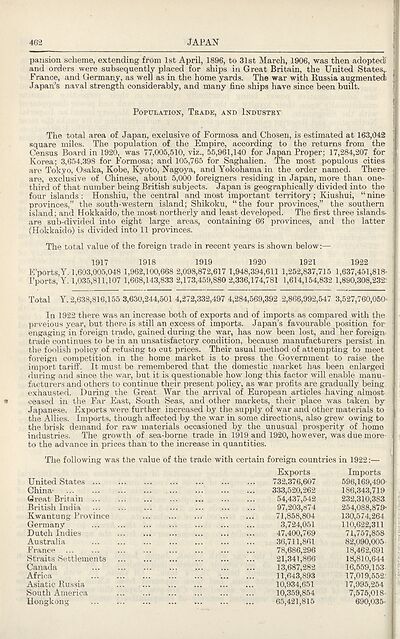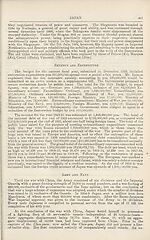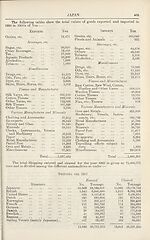1924
(518) Page 462
Download files
Complete book:
Individual page:
Thumbnail gallery: Grid view | List view

462
JAPAN
pansion scheme, extending from 1st April, 1896, to 31st March, 1906, was then adopted'
and orders were subsequently placed for ships in Great Britain, the United States,.
Franee, and Germany, as well as in the home yards. The war with Russia augmented
Japan’s naval strength considerably, and many fine ships have since been built.
Population, Teade, and Industkv
The total area of Japan, exclusive of Formosa and Chosen, is estimated at 163,042
square miles. The population of the Empire, according to the returns from the
Census Board in 1920, was 77,005,510, viz., 55,961,140 for Japan Proper; 17,284,207 for
Korea; 3,654,398 for Formosa; and 105,765 for Saghalien. The most populous cities
are Tokyo, Osaka, Kobe, Kyoto, Nagoya, and Yokohama in the order named. There-
are, exclusive of Chinese, about 5,000 foreigners residing in Japan, more than one-
third of that number being British subjects. Japan is geographically divided into the-
four islands : Honshiu, the central and most important territory; Kiushui, “ nine
provinces,” the south-western island; Shikoku, “the four provinces,” the southern
island; and Hokkaido, the most northerly and least developed. The first three islands-
are sub-divided into eight large areas, containing 66 provinces, and the latter
(Hokkaido) is divided into 11 provinces.
The total value of the foreign trade in recent years is shown below
1917 1918 1919 1920 1921 1922
E’ports,Y. 1,603,005,048 1,962,100,668 2,098,872,617 1,948,394,611 1,252,837,715 1,637,451,818-
I’ports, Y. 1,035,811,107 1,668,143,833 2,173,459,880 2,336,174,781 1,614,154,832 1,890,308,232:
Total Y. 2,638,816,155 3,630,244,501 4,272,332,497 4,284,569,392 2,866,992,547 3,527,760,050-
In 1922 there was an increase both of exports and of imports as compared with the
prveious year, but there is still an excess of imports. Japan’s favourable position for
engaging in foreign trade, gained during the war, has now been lost, and her foreign,
trade continues to be in an unsatisfactory condition, because manufacturers persist in
the foolish policy of refusing to cut prices. Their usual method of attempting to meet
foreign competition in the home market is to press the Government to raise the
import tariff. It must be remembered that the domestic market has been enlarged
during and since the war, but it is questionable how long this factor will enable manu¬
facturers and others to continue their present policy, as war profits are gradually being;
exhausted. During the Great War the arrival of European articles having almost
ceased in the Far East, South Seas, and other markets, their place was taken by
Japanese. Exports were further increased by the supply of war and other materials to
the Allies. Imports, though affected by the war in some directions, also grew owing to
the brisk demand for raw materials occasioned by the unusual prosperity of home
industries. The growth of sea-borne trade in 1919 and 1920, however, was due more
to the advance in prices than to the increase in quantities.
The following was the value of the trade with certain foreign countries in 1922:—
United States ...
China-
Great Britain ...
British India
Kwantung Province
Germany
Dutch Indies
Australia
France . ...
Straits Settlements
Canada
Africa
Asiatic Russia
South America
Hongkong
Exports
732,376,607
333,520,262
54,437,542
97,203,874
71,858,804
3,724,051
47,400,769
36,711,861
78,686,296
21,341,866
13,687,282
11,643,893
10,934,651
10,359,854
65,421,815
Imports
596,169,490”
186,343,719
232,310,383
254,088.879*
130,574,264
110,622,311
71,757,858
82,090,005
18,462,691
18,810,644
16,559,153
17,019,552:
17,995,254
7,575,018-
690,035-
JAPAN
pansion scheme, extending from 1st April, 1896, to 31st March, 1906, was then adopted'
and orders were subsequently placed for ships in Great Britain, the United States,.
Franee, and Germany, as well as in the home yards. The war with Russia augmented
Japan’s naval strength considerably, and many fine ships have since been built.
Population, Teade, and Industkv
The total area of Japan, exclusive of Formosa and Chosen, is estimated at 163,042
square miles. The population of the Empire, according to the returns from the
Census Board in 1920, was 77,005,510, viz., 55,961,140 for Japan Proper; 17,284,207 for
Korea; 3,654,398 for Formosa; and 105,765 for Saghalien. The most populous cities
are Tokyo, Osaka, Kobe, Kyoto, Nagoya, and Yokohama in the order named. There-
are, exclusive of Chinese, about 5,000 foreigners residing in Japan, more than one-
third of that number being British subjects. Japan is geographically divided into the-
four islands : Honshiu, the central and most important territory; Kiushui, “ nine
provinces,” the south-western island; Shikoku, “the four provinces,” the southern
island; and Hokkaido, the most northerly and least developed. The first three islands-
are sub-divided into eight large areas, containing 66 provinces, and the latter
(Hokkaido) is divided into 11 provinces.
The total value of the foreign trade in recent years is shown below
1917 1918 1919 1920 1921 1922
E’ports,Y. 1,603,005,048 1,962,100,668 2,098,872,617 1,948,394,611 1,252,837,715 1,637,451,818-
I’ports, Y. 1,035,811,107 1,668,143,833 2,173,459,880 2,336,174,781 1,614,154,832 1,890,308,232:
Total Y. 2,638,816,155 3,630,244,501 4,272,332,497 4,284,569,392 2,866,992,547 3,527,760,050-
In 1922 there was an increase both of exports and of imports as compared with the
prveious year, but there is still an excess of imports. Japan’s favourable position for
engaging in foreign trade, gained during the war, has now been lost, and her foreign,
trade continues to be in an unsatisfactory condition, because manufacturers persist in
the foolish policy of refusing to cut prices. Their usual method of attempting to meet
foreign competition in the home market is to press the Government to raise the
import tariff. It must be remembered that the domestic market has been enlarged
during and since the war, but it is questionable how long this factor will enable manu¬
facturers and others to continue their present policy, as war profits are gradually being;
exhausted. During the Great War the arrival of European articles having almost
ceased in the Far East, South Seas, and other markets, their place was taken by
Japanese. Exports were further increased by the supply of war and other materials to
the Allies. Imports, though affected by the war in some directions, also grew owing to
the brisk demand for raw materials occasioned by the unusual prosperity of home
industries. The growth of sea-borne trade in 1919 and 1920, however, was due more
to the advance in prices than to the increase in quantities.
The following was the value of the trade with certain foreign countries in 1922:—
United States ...
China-
Great Britain ...
British India
Kwantung Province
Germany
Dutch Indies
Australia
France . ...
Straits Settlements
Canada
Africa
Asiatic Russia
South America
Hongkong
Exports
732,376,607
333,520,262
54,437,542
97,203,874
71,858,804
3,724,051
47,400,769
36,711,861
78,686,296
21,341,866
13,687,282
11,643,893
10,934,651
10,359,854
65,421,815
Imports
596,169,490”
186,343,719
232,310,383
254,088.879*
130,574,264
110,622,311
71,757,858
82,090,005
18,462,691
18,810,644
16,559,153
17,019,552:
17,995,254
7,575,018-
690,035-
Set display mode to:
![]() Universal Viewer |
Universal Viewer | ![]() Mirador |
Large image | Transcription
Mirador |
Large image | Transcription
Images and transcriptions on this page, including medium image downloads, may be used under the Creative Commons Attribution 4.0 International Licence unless otherwise stated. ![]()
| Asian directories and chronicles > 1924 > (518) Page 462 |
|---|
| Permanent URL | https://digital.nls.uk/196430617 |
|---|
| Attribution and copyright: |
|
|---|---|
| Description | Volumes from the Asian 'Directory and Chronicle' series covering 1917-1941, but missing 1919 and 1923. Compiled annually from a multiplicity of local sources and research. They provide listings of each country's active corporations, foreign residents and government agencies of all nationalities for that year, together with their addresses. Content includes: various treaties; coverage of conflicts; currencies and taxes; consular fees; weights and measures; public holidays; festivals and traditions. A source of information for both Western states and communities of foreigners living in Asia. Published by Hongkong Daily Press. |
|---|---|
| Shelfmark | H3.86.1303 |
| Additional NLS resources: |

